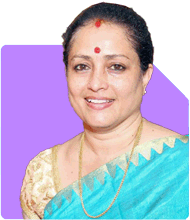My Vision Dropped Suddenly - Will PRP Laser Help?
Dr Karthiyayini Mahadevan | Answer |Ask -Follow
General Physician - Answered on Jul 05, 2024
She specialises in general medicine, child development and senior citizen care.
A graduate from Madurai Medical College, she has DNB training in paediatrics and a postgraduate degree in developmental neurology.
She has trained in Tai chi, eurythmy, Bothmer gymnastics, spacial dynamics and yoga.
She works with children with development difficulties at Sparrc Institute and is the head of wellness for senior citizens at Columbia Pacific Communities.... more

I am 53 year old male with weight of 70 kgs.6 months back suddenly my vision gone about 50% and I was detected CRVO with macular odema.I have taken 3 intraviral injections also There is no improvement in the vision of my affected eye. Now doctor is suggesting to go for PRP laser treatment for prevention of Neovascular gluacoma.What to do ?? Can my vision will be normal as before ??
Please try and see if you can get some inputs from them.
They teach certain exercices which has helped many in different case scenarios.
Also see if you can get Yoga for perfect eyesight book written by Dr. Agarwal which gives certain useful tips
Third option
In Kerala there is an Ayurvedic place called Sreedhareeyam particularly for eye related problems kindly check on that
You may like to see similar questions and answers below
Dr Karthiyayini Mahadevan | Answer |Ask -Follow
General Physician - Answered on Apr 25, 2023
Dr Karthiyayini Mahadevan | Answer |Ask -Follow
General Physician - Answered on Apr 17, 2023
Dr Karthiyayini Mahadevan | Answer |Ask -Follow
General Physician - Answered on Apr 30, 2023
Dr Deepa Suvarna |171 Answers |Ask -Follow
Paediatrician - Answered on May 12, 2023
Dr Karthiyayini Mahadevan | Answer |Ask -Follow
General Physician - Answered on Sep 06, 2023
Ramalingam Kalirajan |10890 Answers |Ask -Follow
Mutual Funds, Financial Planning Expert - Answered on Dec 15, 2025
Ramalingam Kalirajan |10890 Answers |Ask -Follow
Mutual Funds, Financial Planning Expert - Answered on Dec 15, 2025
Samraat Jadhav |2508 Answers |Ask -Follow
Stock Market Expert - Answered on Dec 15, 2025
Ramalingam Kalirajan |10890 Answers |Ask -Follow
Mutual Funds, Financial Planning Expert - Answered on Dec 15, 2025
Reetika Sharma |425 Answers |Ask -Follow
Financial Planner, MF and Insurance Expert - Answered on Dec 15, 2025
Radheshyam Zanwar |6745 Answers |Ask -Follow
MHT-CET, IIT-JEE, NEET-UG Expert - Answered on Dec 15, 2025
Reetika Sharma |425 Answers |Ask -Follow
Financial Planner, MF and Insurance Expert - Answered on Dec 15, 2025
Ramalingam Kalirajan |10890 Answers |Ask -Follow
Mutual Funds, Financial Planning Expert - Answered on Dec 15, 2025
Ramalingam Kalirajan |10890 Answers |Ask -Follow
Mutual Funds, Financial Planning Expert - Answered on Dec 15, 2025
Ramalingam Kalirajan |10890 Answers |Ask -Follow
Mutual Funds, Financial Planning Expert - Answered on Dec 15, 2025
























.jpg)

